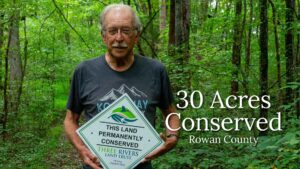
I was able to take a “Legacy of the Land” tour at Biltmore on New Year’s Eve (I would say earlier this year, but since it was technically 2018, it was last year when I went). This was a fascinating tour of the land that is part of the Biltmore Estate. I had only previously been in the house, which is mesmerizing on its own, but a guided tour of the grounds proved to be even more captivating – especially with my interest in land and forests and all things outdoors.
The tour guide gave a brief history of the estate. He said that George Vanderbilt owned 125,000 acres when he died. He had 13 children and almost his entire inheritance went to his first-born son. George’s father, William, had 8 children and was worth $220 million when he died. They said that at that time, one out of every $10 was a Vanderbilt dollar. William divided the money and gave the most to his two oldest sons. George is the youngest son and he got $10 million and an extra $2 million to take care of his mother, who at the time was suffering from malaria.
George was an equestrian and was riding around these North Carolina Mountains and fell in love with the view here at what would be become the Biltmore Estate. All the trees had been cut down by that time and he did not buy pristine land, but worn out sterile land. He hired Richard Morris Hunt as his building architect and Frederick Law Olmsted as his landscape architect to help him turn this property into something special. There were 2.9 million trees and shrubs planted. Currently, about 9% of the forestry budget goes into treating invasive plants – including bamboo. There are 20 types of bamboo at the Biltmore estate, and we saw some of the “pygmy bamboo” on our tour.
Charles McNamee, an attorney, was hired by Vanderbilt to buy land for his new home. Our tour guide reported that to buy the entire estate took over 1200 land transactions in 4 counties. We took one stop along the way to look at what was once a small African-American community made up of freedmen called Shiloh, of approximately 28 families and 200 acres. The approach road to Biltmore went through this community. Land in this area was going for $7 an acre, and McNamee offered the landowners $35 an acre. Some of them took the offer and some did not. McNamee offered those who did not take it better land 2 and ½ miles away as a trade. They moved the church and the graves of the people buried there and called it the New Shiloh Community. We got out of the bus here, and you can still see impressions in the ground where the graves were.
Biltmore wanted the estate to be self-sustaining. It had its own herds of sheep, swine, poultry and nurseries. There was a dairy farm there with 200 cows brought down from the family farm in New York. The first managed forests in the country were located here at the Biltmore estate. The Biltmore Forest School was the first school of forestry in North America. The forests were designed by Olmsted, but managed by Gifford Pinchot. Carl Schenck eventually replaced Pinchot, and Schenck founded the Biltmore Forest School in 1898. Graduates of this school were the country’s first professional foresters. This former school forms the basis for the “Cradle of Forestry,” a 6500-acre historic site that houses exhibits about forestry and forestry conservation.
The property taxes were a lot for this land, and the family eventually had to sell some of the land to the government – what would become part of Pisgah National Forest. Edith, George’s wife, sold 80,000 acres for $5 an acre, or $400,000 to the US government. Because this was such a large sum at that time, the government had to pay her over time.
I am glad that the Vanderbilts chose to purchase land in our North Carolina mountains and create a legacy here of forestry and forest conservation, and that they chose to sell some of their precious property to become part of the national forest. I’m also glad I had the opportunity to see the land associated with the house, which is still owned by Vanderbilt heirs. If you have an interest in land and history and ever get the chance to take this tour, I’d encourage you to do so. I have shared some of the information provided with you in this article, but there is a lot more history to the site than I have time to provide you with. Consider taking this tour the next time you’re in the area – it is worth checking out.